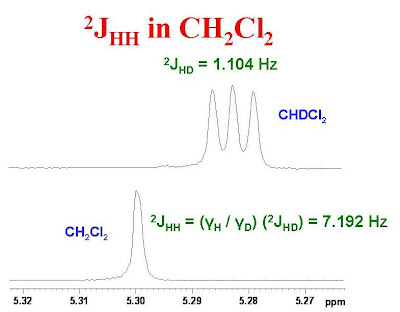When many chemists are asked what is the 2JH-H coupling for compounds like methane, acetone, methylene chloride, dimethyl ether or DMSO, they will often return a look of confusion. "There is no coupling," they will say, "the proton spectrum is a singlet". Indeed the proton spectrum is a singlet for these compounds but 2JH-H is not equal to zero. The only reason that the coupling is not observed in the spectrum is because the chemical shifts of each proton are identical. The coupling can easily be measured by observing the spectrum of a partially deuterated isotopomer. The 2JH-H coupling constant is equal to 2JH-D multiplied by the ratio of the gyromagnetic ratios of 1H to 2H. This is illustrated in the figure below for methylene chloride.

In fact, 2JH-H is -7.192 Hz not +7.192 Hz however, this cannot be determined simply by observing the spectrum. Both spectra were measured for dilute solutions with CDCl3 as solvent. The residual protons of CDCl3 were used as the chemical shift reference (7.26 ppm). The chemical shift difference between CH2Cl2 and CHDCl2 is due to an isotope effect.